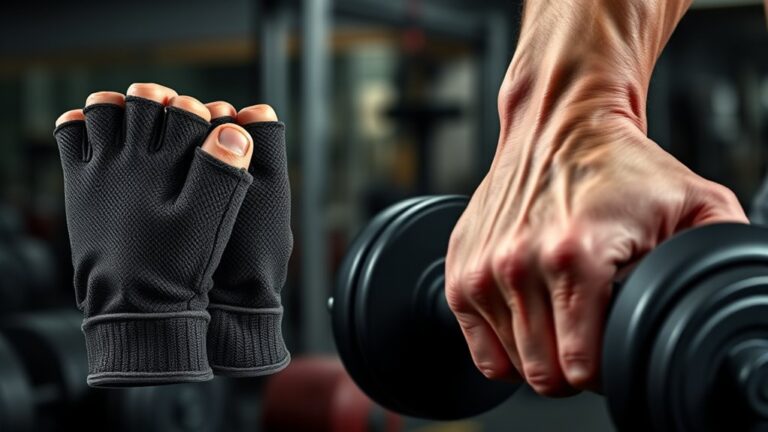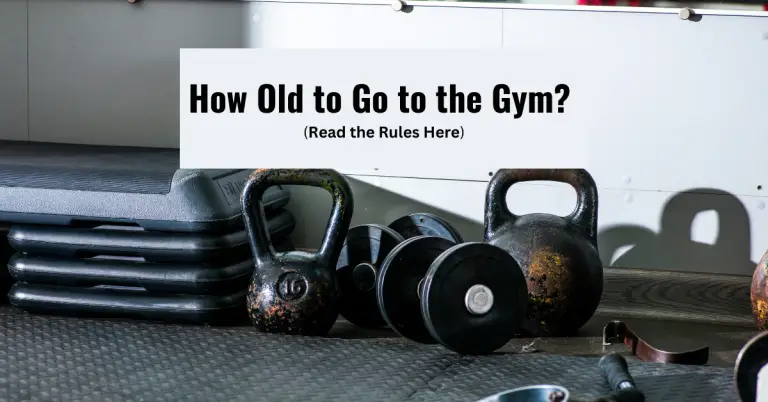How to Reduce Muscle Soreness After a Workout

To reduce muscle soreness after a workout, you should start with proper warm-ups and follow up with effective cool-down techniques like stretching. Focus on nutrition by balancing protein and carbohydrates to aid recovery. Stay hydrated by drinking water and consider electrolyte-rich drinks during intense sessions. Incorporate stretching and foam rolling post-workout to improve flexibility and blood flow. Also, don’t overlook the role of rest and possible supplements in enhancing muscle repair. There’s more to discover about optimizing your recovery!
Importance of Proper Warm-Ups

Even if you’re enthusiastic to dive right into your workout, proper warm-ups are essential for preventing muscle soreness. Skipping this step can lead to injuries and discomfort that could sideline you. Start with dynamic stretching, which involves movement-based stretches that elevate your heart rate and prepare your muscles for activity. This isn’t just about flexibility; it’s about muscle activation. By engaging your muscles through various movements, you enhance blood flow and energy, helping them perform better during your workout.
Incorporate exercises like leg swings, arm circles, and torso twists into your warm-up routine. These dynamic stretches not only prepare your muscles for the demands of your workout but also improve your overall performance. Remember, a few extra minutes spent warming up can make a significant difference in how your body feels post-workout. So, don’t rush; prioritize a proper warm-up to keep soreness at bay.
Effective Cool-Down Techniques
After a workout, cooling down is just as essential as warming up. Incorporating stretching exercises and active recovery methods can help reduce muscle soreness and promote flexibility. Let’s explore how these techniques can enhance your post-workout routine.
Stretching Exercises Importance
While you might feel tempted to skip stretching after a workout, incorporating effective cool-down techniques is essential for reducing muscle soreness. Stretching helps improve flexibility and promotes blood flow to your muscles, aiding recovery.
Here are some important stretching exercises to reflect upon:
- Dynamic stretching before workouts to warm up your muscles
- Static stretching post-workout to enhance flexibility
- Focus on major muscle groups, like hamstrings and quadriceps
- Hold stretches for at least 15-30 seconds to maximize benefits
- Breathe deeply during stretches to relax your muscles
Active Recovery Methods
In addition to stretching, employing active recovery methods can considerably aid in reducing muscle soreness post-workout. Incorporating low intensity workouts, like gentle cycling or walking, helps maintain blood flow to your muscles without overexerting them. These activities can flush out lactic acid and speed up recovery. Additionally, engaging in yoga practices is an excellent way to enhance flexibility and promote relaxation. Gentle poses and deep breathing can alleviate tension and improve circulation, making it easier for your body to heal. Remember to listen to your body; if you feel any pain, modify your routine or take a break. By prioritizing these active recovery methods, you’ll support your muscles in recovering safely and effectively.
The Role of Nutrition in Recovery

Nutrition plays an essential role in your recovery process, as what you eat can greatly impact muscle repair and soreness. Achieving a proper macronutrient balance is crucial, especially after intense workouts. Focus on nutrient timing as well, ensuring you fuel your body at strategic moments.
Here are some key nutritional elements to take into account:
- Protein: Supports muscle repair and growth.
- Carbohydrates: Replenishes glycogen stores for energy.
- Healthy Fats: Aids in reducing inflammation.
- Vitamins and Minerals: Essential for overall health and recovery.
- Antioxidants: Help combat oxidative stress from exercise.
Staying Hydrated for Optimal Performance
Staying properly hydrated is essential for your performance, especially during and after workouts. Dehydration can lead to fatigue, decreased endurance, and increased muscle soreness, so it’s important to drink enough water. Here are some hydration tips: aim to drink water before, during, and after your exercise sessions. Consider consuming electrolyte-rich drinks if you’re doing high-intensity workouts or sweating excessively.
The hydration benefits extend beyond just performance; staying hydrated helps your muscles recover more efficiently, reducing soreness. Pay attention to your body’s signals—thirst is a clear indicator that you need more fluids. You can also monitor the color of your urine; light yellow generally means you’re well-hydrated. Always keep a water bottle handy, making it easier to sip throughout the day. By prioritizing hydration, you’ll enhance your workout results and help your body bounce back quicker from the strains of exercise.
Incorporating Stretching and Foam Rolling

While you might be enthusiastic to jump into your next workout, incorporating stretching and foam rolling into your routine can greatly reduce muscle soreness and enhance recovery. Dynamic stretching before and after workouts prepares your muscles and improves flexibility. Foam rolling, a form of self myofascial release, helps alleviate tightness and promotes blood flow.
Here are some key techniques to reflect upon:
- Dynamic Stretching: Perform movements like leg swings or arm circles before workouts.
- Foam Rolling: Roll over major muscle groups, focusing on tender spots.
- Hold Stretches: After workouts, hold static stretches for 20-30 seconds.
- Target Specific Areas: Focus on quads, hamstrings, and your back with foam rollers.
- Listen to Your Body: If something feels painful, modify your approach.
Utilizing Rest and Active Recovery
Although many people think pushing through soreness is the best way to get stronger, incorporating rest and active recovery into your routine is essential for ideal recovery. Rest benefits are significant; they allow your muscles to heal and rebuild, reducing soreness and preventing injury. You don’t need to be completely inactive, though. Active recovery techniques, like light walking or gentle cycling, can boost blood flow and help alleviate tightness without overexerting yourself.
Listen to your body—if you feel fatigued, it’s okay to take a break. Incorporating rest days into your routine isn’t a sign of weakness; it’s a smart strategy for long-term progress. Aim for at least one rest day a week, and consider alternating between intense workouts and lighter activities. By prioritizing rest and active recovery, you’ll enhance your overall performance and make your workouts more effective in the long run.
Considering Supplements for Muscle Repair
When it comes to muscle repair, certain supplements can make a real difference in your recovery process. You’ll want to contemplate not just what to take, but also when to take it, and whether you prefer natural or synthetic options. Understanding these factors can help you optimize your post-workout recovery.
Key Supplements for Recovery
To enhance your recovery and minimize muscle soreness, pondering key supplements can be a game changer. These options help support muscle repair and overall health, making your workouts more effective and enjoyable. Here are some supplements to ponder:
- BCAAs: Known for their muscle recovery benefits, they can reduce soreness after intense workouts.
- Creatine: A safe option; ascertain you follow recommended creatine dosage for ideal results.
- Omega-3: Found in fatty fish, these sources can help reduce inflammation and promote recovery.
- Glutamine: Plays a crucial role in muscle repair and immune function.
- Turmeric: Its antioxidant effects can aid in reducing soreness and inflammation.
Incorporating these into your routine is essential for a smoother recovery journey.
Timing of Supplement Intake
Understanding the timing of supplement intake is essential for maximizing muscle repair and minimizing soreness after your workouts. By implementing effective timing strategies, you can enhance the benefits of various supplement types.
| Supplement Type | Best Timing | Benefits |
|---|---|---|
| Protein | Within 30 minutes post-workout | Supports muscle synthesis |
| Creatine | Before or after workout | Enhances energy and recovery |
| Omega-3 Fatty Acids | Daily, with meals | Reduces inflammation |
Taking supplements at the right time can notably influence your recovery process. For safety, always consult with a healthcare professional before starting any new supplement regimen, ensuring they align with your individual needs and goals.
Natural vs. Synthetic Options
Choosing between natural and synthetic supplements for muscle repair can be an important decision for your recovery strategy. While natural remedies often come with fewer side effects, synthetic alternatives might provide faster results. It’s vital to assess what’s best for your body. Here are some factors to reflect on:
- Efficacy: Natural remedies may take longer to show results.
- Side Effects: Synthetic alternatives can lead to unwanted reactions.
- Cost: Natural options are often more affordable in the long run.
- Availability: Synthetic supplements may be easier to find.
- Quality Control: Natural products can vary widely in quality.
Ultimately, your choice should align with your safety preferences and fitness goals, ensuring a well-rounded approach to recovery.
Frequently Asked Questions
How Long Does Muscle Soreness Typically Last After a Workout?
Muscle soreness typically lasts anywhere from 24 to 72 hours after a workout. However, soreness duration can vary based on several factors, like the intensity of your workout, your fitness level, and the specific muscle groups targeted. To aid in recovery, consider using muscle recovery techniques such as gentle stretching or light activity. Listening to your body is essential; if the soreness persists longer than expected, you might want to consult a professional.
Are There Specific Workouts That Cause More Soreness Than Others?
Yes, certain workouts can definitely cause more soreness than others. Eccentric training, where muscles lengthen under tension, often leads to increased soreness. High-intensity workouts can also contribute, especially if you’re pushing your limits. It’s important to ease into these types of exercises to prevent injury. Always listen to your body, and consider allowing adequate recovery time to minimize discomfort while maximizing your progress. Safety should always come first in your fitness journey.
Can I Workout Through Muscle Soreness?
You can workout through muscle soreness, but it’s important to listen to your body. Engaging in active recovery, like light walking or stretching, can help manage soreness without overdoing it. If the pain is mild, low-intensity exercises might be okay; however, if it feels sharp or severe, it’s better to rest. Prioritizing soreness management guarantees you avoid injury and can return to your regular workouts safely and effectively.
Is Muscle Soreness a Sign of a Good Workout?
You might think muscle soreness equals a killer workout, like it’s a badge of honor. While some soreness is normal and can indicate increased workout intensity, it doesn’t always mean you’ve hit your peak performance. It’s crucial to listen to your body; muscle recovery matters. Overdoing it can lead to injury. Guarantee you balance intensity with proper recovery techniques, so you stay safe and keep progressing toward your fitness goals.
How Can I Differentiate Between Soreness and an Injury?
To differentiate between soreness and an injury, you’ve gotta pay attention to soreness indicators and injury signs. Soreness usually feels like a dull ache and occurs after a workout, while an injury often presents sharp pain, swelling, or bruising. If you can move the affected area without significant pain, it’s likely just soreness. However, if the pain worsens or limits your movement, it’s best to consult a professional to avoid further complications.





